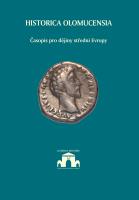Archeologický nález a jeho stopa v písemných pramenech
An archaeological find and its trace in written sources
The grave of an individual with a growth disorder from the cemetery at St. Peter's in Olomouc
Author(s): Hana Dehnerová, Tomáš Jelínek, Jitka Jonová, Lukáš ŠínSubject(s): History, Local History / Microhistory, 17th Century, 18th Century
Published by: Univerzita Palackého v Olomouci
Keywords: Olomouc; archaeological find; achondroplasia; court dwarf; Canon Johann Mathias Thurn;
Summary/Abstract: This study deals with selected findings from archaeological research in a part of the cemetery of the defunct parish church of St. Peter (Olomouc, Křížkovského Street Nr. 10). This cemetery was used for burials from the Middle Ages until 1784. The described findings include grave H176, in which an individual with a growth disorder (achondroplasia) was buried sometime during the Baroque period (1650–1750) and probably with the typical appearance of disproportionate dwarfism (shorter limbs, swaying or hunching of the back). In contemporary sources, these people were referred to as nanus, pumilio, pygmaeus (Latin), der Zwerch/Zwerg (German); piedimužík, mužíček, třpaslek (Old Czech). The aim of this study was to evaluate this uncommon archaeological find and to research whether a person who was different in some way also left a mark in contemporary written sources. The deceased was buried in a wooden coffin in a supine position with his head to the west and his feet to the east, his arms crossed down into his pelvis. The skeleton was well preserved, except for the facial part of the skull, which was damaged. The skeleton is that of a juvenile male with an estimated age of 15 to 20 years, with a gracile physique, marked shortening of the long bones of the limbs, and the spine exhibits excessive lordosis. A stature estimate of 130,95 ± 3,96 cm. The registries of closed parishes of St. Peter and Paul in Olomouc from 1667–1784 were chosen as the primary source of comparative information. An inscription was found for 24 March 1718 stating that a “Pigmeus” was buried from the house of the count and canon “Tuhrn,” who was Johann Matthias, Count of Thurn and Valesassina, the resident canon of Olomouc in 1706–1746. The Count was an important patron and collector of art with a European outlook, and therefore the presence of a dwarf in his court would not have been extravagant at the time. Although chronologically the archaeological find corresponds to the record in the parish register, these two individuals cannot be completely identified with 100% certainty.
Journal: Historica Olomucensia: Journal for Central European History
- Issue Year: 64/2023
- Issue No: 2
- Page Range: 107-120
- Page Count: 14
- Language: Czech

